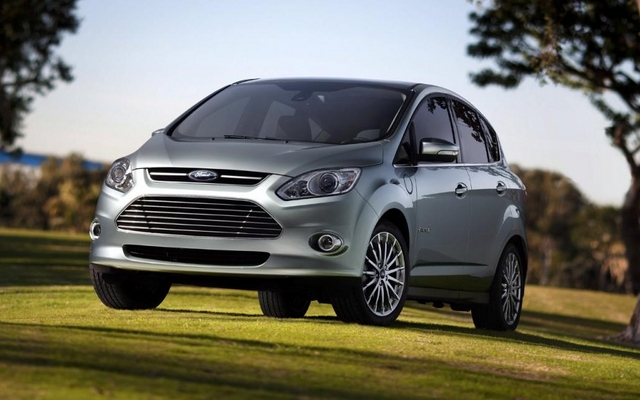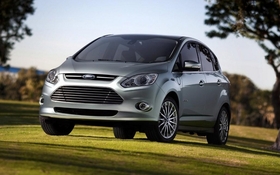Ford to Triple Production Capacity of Electrified Vehicles in North America by 2013
Led by C-MAX Hybrid, C-MAX Energi
• Ford to triple production capacity of electrified vehicles in North America by 2013, investing in even more C-MAX Hybrid and C-MAX Energi plug-in hybrid vehicles
• Expanding production capacity of electrified C-MAX lineup brings a stronger business case than introducing gasoline-powered seven-passenger vehicle in North America
• Ford adding more than 220 green technology jobs in Michigan, including total of 170 at Rawsonville and Van Dyke Transmission plants, plus more than 50 new electrified-vehicle engineers based in Dearborn in the past year
• Production of all-new C-MAX Energi plug-in hybrid and C-MAX Hybrid scheduled to begin at Michigan Assembly Plant in 2012, with locally sourced battery packs and electric drive transaxles built by Michigan workers
Ford Motor Company announced today it is tripling production capacity of its electrified vehicle lineup through 2013, further boosting volumes of its all-new C-MAX Hybrid and C-MAX Energi plug-in hybrid, which begin production next year.
“Customers have come to expect fuel efficiency with every new vehicle Ford delivers today, and now we are further differentiating our electrified vehicle lineup with something else people truly value – choice,” said Jim Farley, Ford’s group vice president of Marketing, Sales and Service. “Whether people want a hybrid, a plug-in hybrid or full battery electric vehicle, we have a family of vehicles for them to consider, providing a range of options to best meet their needs and support their driving habits and lifestyles.”
Ford is electrifying platforms – versus a single vehicle – to offer customers the most choice. Five electrified vehicles are planned for North America by 2012 – including the Transit Connect Electric, on sale now, and Focus Electric this year in the U.S and 2012 in Canada. The C-MAX Energi plug-in hybrid and C-MAX Hybrid will be followed by another next-generation hybrid in 2012.
Today, Ford sells approximately 35,000 electrified vehicles a year, led by the Fusion Hybrid and Escape Hybrid – the most fuel-efficient midsize sedan in North America and the most fuel-efficient SUV in the world, respectively.
Ford will grow its electrified vehicle production capacity to more than 100,000 annually by 2013, thanks to growing consumer appetites for green vehicles and growing desires for stylish new Focus-sized vehicles.
The new Ford C-MAX five-passenger vehicle, which is the base for the C-MAX Hybrid and C-MAX Energi plug-in hybrid, is leaving European dealer lots at twice the rate of last year’s model. More than 100,000 of these new vehicles have been sold in Europe since its launch in late 2010, and Ford is already finding new ways to produce more European C-MAX models than originally expected at its Valencia, Spain, plant.
“European customers are snapping up our C-MAX five-passenger models, telling us they love the vehicle’s sporty appearance, driving quality, interior comfort and clever use of space,” Farley said. “We plan to be aggressive in delivering products like this that people really want and make smart decisions supporting our One Ford plan.”
Ford’s plan to invest in even more capacity for its five-passenger C-MAX electrified models for North America replaces an earlier plan of introducing the gasoline-engine-powered seven-passenger C-MAX multi-activity vehicle.
This also marks the first time North American customers will have the choice of a dedicated body style for a range of Ford electrified vehicles.
Emerging “Green” Centre of Manufacturing Excellence
Both the C-MAX Hybrid and C-MAX Energi models will be built alongside the all-new 2012 Ford Focus and Focus Electric at Ford’s Michigan Assembly Plant in Wayne, Mich., the first plant in the world to produce gasoline-powered vehicles, full-electric vehicles, hybrid and plug-in hybrids under one roof.
The plant’s production is powered in part by one of the largest solar energy generator systems in the state.
The new green vehicle lineup also is bringing jobs to Ford and America.
In total, Ford is adding more than 220 green technology jobs in Michigan alone as the state becomes its centre of excellence for vehicle electrification. This includes a combined 170 jobs at Ford’s Rawsonville and Van Dyke Transmission plants, plus more than 50 new engineers based in Dearborn in the past 12 months specifically for the design and development of key component for Ford hybrids, plug-in hybrids and full battery electric vehicles.
Employees at the Rawsonville Plant in Ypsilanti, Mich., are on tap to assemble advanced lithium-ion battery packs for C-MAX Hybrid, and today Ford confirmed the larger lithium-ion battery packs for C-MAX Energi also will be produced at Rawsonville. Production currently is performed by a supplier in Mexico.
Both battery packs are being designed in-house by Ford engineers. Although the battery packs differ in size, energy storage and power output, they are designed for efficient production in the same flexible manufacturing facility.
Ford’s Van Dyke Transmission Plant in Sterling Heights, Mich., also benefits from electrified versions of the C-MAX. Employees there are building the electric drive transaxles, work currently outsourced to a supplier facility in Japan.
“Ford’s commitment to grow our electrified vehicle family brings good news for our customers, employees, the economy and the environment,” Farley said.
Efficiency comes standard
The new Ford C-MAX Hybrid is targeted to deliver better mpg than Fusion Hybrid and is the first of two new Ford Hybrids to use lithium ion battery technology. Lithium-ion batteries are up to 50 per cent lighter and 25 per cent smaller than current nickel-metal-hydride batteries and increase the amount of energy available to extend the vehicle's driving distance and boost fuel economy.
This all-new hybrid also will travel at a higher all-electric speed than Fusion Hybrid’s 75 km/h.
The C-MAX Energi, featuring a 240-volt charging system, will be able to fully recharge faster than Chevy Volt and is being engineered to deliver more overall driving range than any other plug-in or extended range electric vehicle. It is also targeted to achieve AT-PZEV status.












